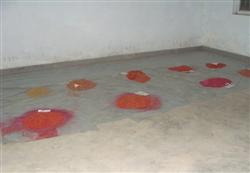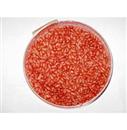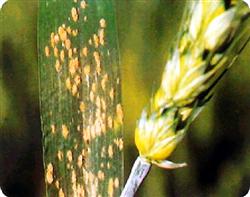What is the use of wheat seed dressing?

What's the use of seed dressing? please brief us on Wheat seed dressing specifically, one is safe for seeds, wheat seedlings are neat and consistent, seedlings grow strong; Second, it has good prevention effect on wheat seed-borne diseases and soil-borne diseases, and can effectively control various diseases in wheat seedling stage; Third, it has a long effective period, which can protect wheat seedlings for a long time and avoid the threat of disease infection; Fourth, the yield increase effect is obvious, the yield increase per mu is about 10~15%; Seed dressing operation is simple and the drug effect is lasting and stable. Wheat seed dressing mainly controls the following diseases and insect pests: First, soil-borne diseases, mainly sheath blight, total erosion, root rot. These pathogens can live in the soil for many years and can infect wheat when seeds begin to sprout after seed dressing. The other is systemic infection disease, mainly stem smut, scattered smut and bunchy smut. The pathogen invades the growth point from seed germination, and systematically infects with wheat plant growth, showing harmful symptoms at ear stage. Third, underground pests, mainly grubs, mole crickets and insects, they bite wheat rhizomes in autumn seedling stage and after returning to green, resulting in lack of seedlings and broken ridges. An effective method is seed dressing. Fourth, ground pests, mainly small brown planthopper and so on. Seed dressing with pesticides should be used to control wheat diseases and insect pests in different areas. According to the occurrence of local diseases and insect pests, the types, application methods and dosage of seed dressing pesticides should be determined. 1. Control of wheat rust For the areas where multiple pests occur simultaneously and alternately at seedling stage, it is advisable to select fungicides and insecticides for mixed seed dressing to achieve the purpose of controlling underground pests, midges, aphids and other seedling pests. Triadimefon and other fungicides have low effective concentration, and seed dressing at the proportion of 0.03%(effective component) of dry seed weight can achieve good disease control effect. After treatment of wheat seeds with chemicals, slow emergence (generally 1~2 days late) and plant dwarfing often occur, but there is no adverse effect on emergence rate, late growth and yield. If overdosed, it can lead to phytotoxicity. 2. Prevention and control of underground pests Mixing wheat seeds with chemicals and treating soil before sowing are the most effective measures to control underground pests of wheat. Seed dressing treatment: In the general occurrence area of underground pests, the method of seed dressing with chemicals can be used for control. 50% phoxim can be selected for seed dressing, 0.2% of seed amount, i.e. 100 g of 100 jin seed, mixed with 2-3 kg of water, or 48% chlorpyrifos emulsifiable solution can be used for seed dressing according to 0.3% of seed weight, and can be sown after 4-6 hours of mixing, which can effectively control underground pests. Soil treatment: soil treatment and seed dressing should be used to control serious occurrence areas of underground pests. Soil treatment can be evenly spread on the ground with 2-2.5 kg of phoxim granules of 3% per mu, and then turned into soil. Can also mu with 50% phoxim emulsifiable concentrate 250 ml, mixed with water 1-2 kg, mixed with fine soil 20? 25 kilograms of poison soil, evenly scattered on the ground, and then turned into the soil. 3. Prevention and control of stink-smut, take-all disease and powdery mildew Seed dressing with pesticides can not only control wheat smut, but also effectively control the occurrence and damage of rust, take-all disease and powdery mildew of wheat before winter, and reduce the amount of overwintering bacteria. (1) In the occurrence areas of scattered smut, stinkhead, root rot, sheath blight and take-all disease, 40% quintozene can be used for dry mixing according to 0.5% of wheat seed weight.(i.e. 40g per mu, mixed with wheat about 8kg), to prevent and control wheat smut; also can choose 6% tebuconazole suspension (10ml), add water 0.8-1 jin, seed dressing 50-70 jin, or 2.5% fludioxonil suspension according to the recommended dose for wheat seed dressing, at the same time can also control autumn seedling rust and powdery mildew; Seed dressing with 15% triadimefon WP according to 0.2% seed weight or 20% triadimefon EC 1 jin with 5 jin water, mixed with wheat seed 500 jin, can control powdery mildew and leaf rust. (2) 12.5% silanthiabendazole suspension could be used to treat seeds in the serious occurrence area of wheat take-all disease, which had good control effect on wheat take-all disease. Generally use a bag (20ml) of total erosion net, first add 300- 500ml water, mix 20-25 jin seeds, mix well and then plant for 6-12 hours (conducive to the use of chemicals and kill the germs carried by seeds), and sow in the shade after drying. (3) Imidacloprid can be used to treat seeds in wheat yellow dwarf disease and bush dwarf disease occurrence areas to control virus transmitting insects, control the occurrence of wheat yellow dwarf disease and bush dwarf disease, and control underground pests at the same time. (4) In areas where a variety of diseases and pests occur, it is necessary to vigorously promote the application of seed coating agents or seed dressing agents composed of fungicides and insecticides for coating or seed treatment. According to the local main pest species, the appropriate formulation of seed coating or seed dressing agent should be selected, and its dosage is generally the same as that of single agent in compound (mixed) agent. Click for more wheat growing technology Click for more grain growing technology
- Prev

What's the use of wheat seed coating?
What's the use of wheat seed coating? Please introduce that seed coating and chemical seed dressing before wheat sowing is a key measure to lower the base number of diseases and insect pests, move forward the control gate, and reduce the occurrence of diseases and insect pests in the coming year. Seed coating can effectively prevent and control wheat rust, powdery mildew, sheath blight, smut and so on.
- Next

How to control wheat diseases and insect pests
How to control wheat diseases and insect pests? Please give guidance and introduce the following control methods for the prevention and control of wheat diseases and insect pests: stripe rust: adopt the strategy of "find one point and control one piece" in early spring, take medicine to detect and block the disease center, and combine spot control with general treatment in spring. seriously diseased fields and susceptible varieties see the progress of the disease.
Related
- The first cup of black tea in spring, the flavor and history of tea gardens in Kenya, Africa
- The computer can not only choose potatoes, but also grow tea rice. AI will grow winter oolong tea champion.
- It is not only the inflated tea bitten by insects, but also engraved with the four seasons tea in Beipu.
- The Oriental Beauty Tea Festival in Zhuxian County takes the stage at the weekend to experience the plus-size feast of oil tea.
- & quot; Oriental Beauty Tea & Exploration of Emei in Hsinchu, the hometown of quot;
- The new variety of strawberry "Tainong 1" dessert is the first choice with mellow aroma. Crimson gorgeous
- History of Tea in Taiwan: from Wild Inner Mountain to Export Tea Garden
- Two types of Taiwan Oriental Beauty Black Tea won the British three-Star Award for Childhood Tea Xiang Zhang Jiaqi changed from pilot to champion tea maker.
- Banana species and varieties: the planting history of Taiwan Xianren banana and dwarf banana is long, is banana disease resistant?
- Coffee planting Technology: Qianjie Coffee from Seedling to harvesting

